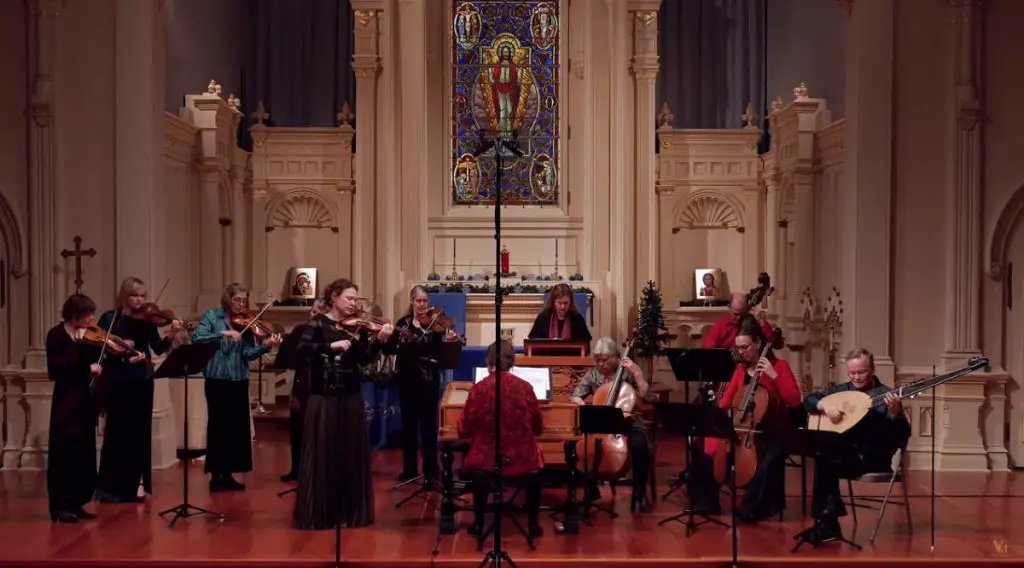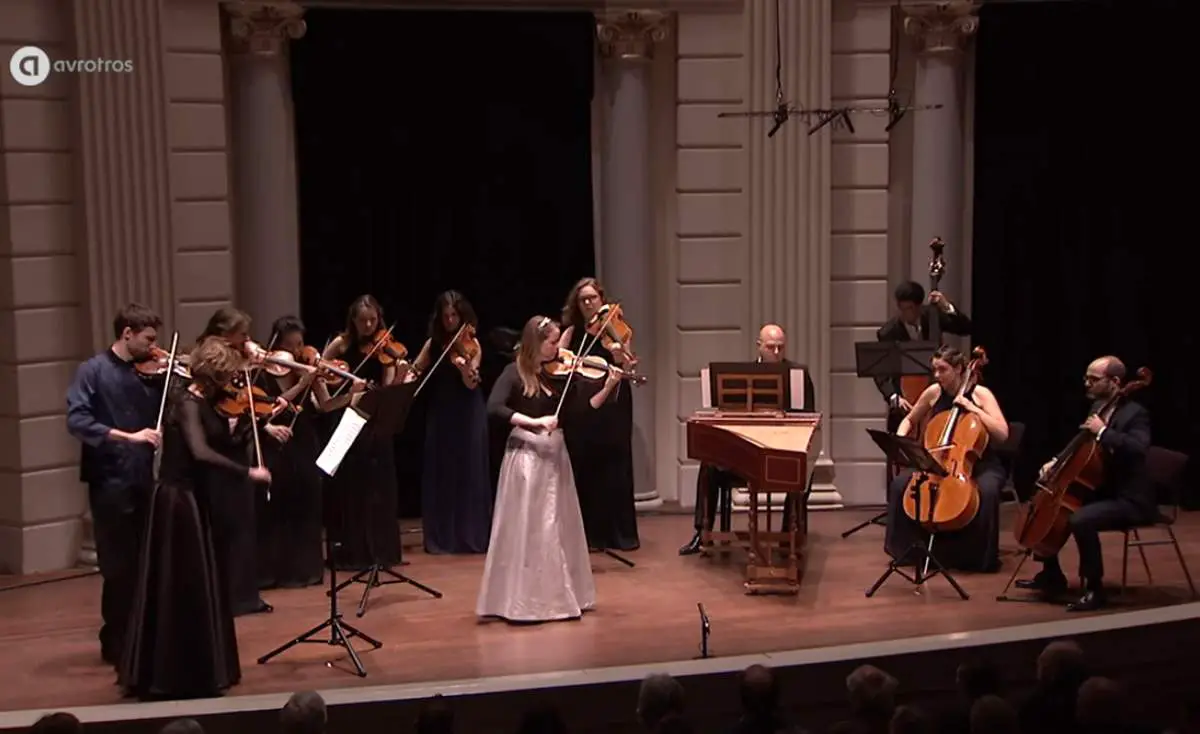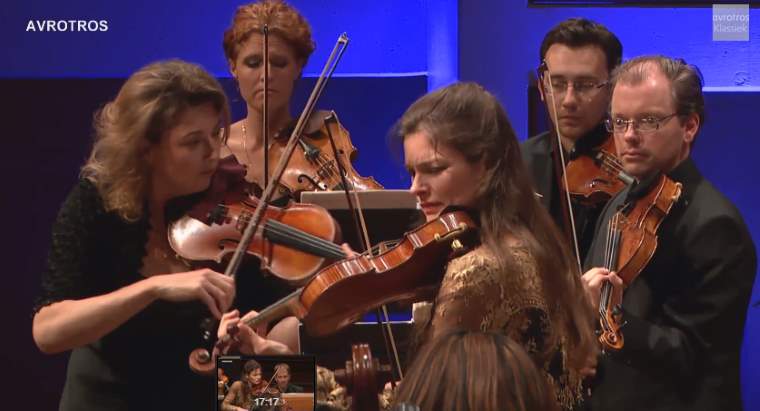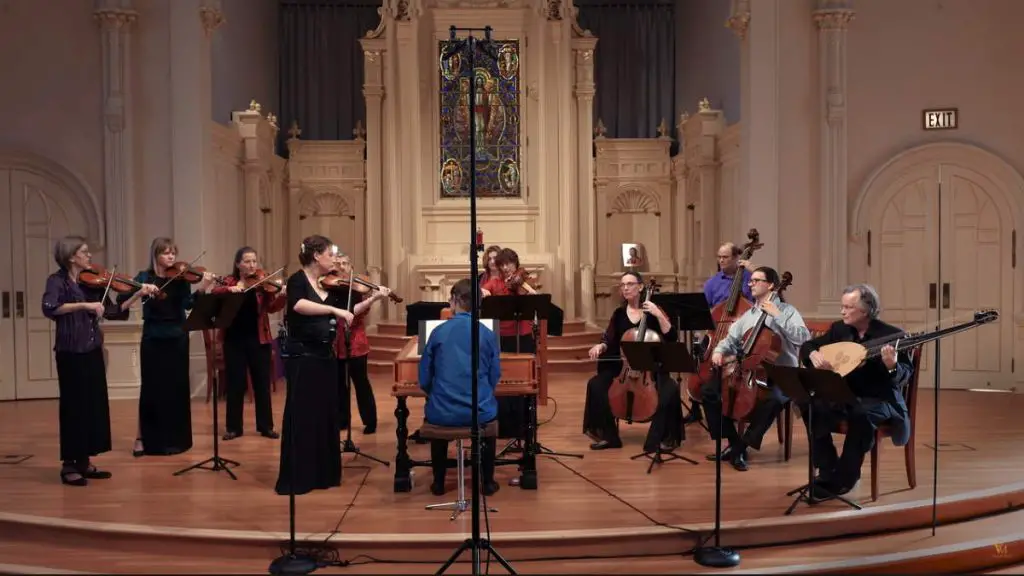Accompanied by the San Francisco-based early music ensemble Voices of Music, the American violinist Cynthia Miller Freivogel who specialized in both baroque and modern violin performs Antonio Vivaldi’s “Winter” from The Four Seasons. The piece was performed on original period instruments.
Vivaldi: Concerto No. 4 in F minor, Op. 8, RV 297, “L’inverno” [Winter]
Antonio Vivaldi’s Concerto No. 4 in F minor, Op. 8, RV 297, popularly known as “L’inverno” (Winter), is a masterpiece that vividly captures the essence of winter. This piece is part of Vivaldi’s much-celebrated collection, “Le quattro stagioni” (The Four Seasons), which consists of four violin concertos, each representing a season. Composed around 1723, these concertos are among the earliest examples of program music – music with a narrative element.
Winter, as depicted by Vivaldi in this concerto, is evocative and rich in imagery. The composer’s intention was not just to write a technically proficient piece, but to create a soundscape that immerses the listener in the varied moods and scenes of winter. This concerto, like others in the series, is accompanied by sonnets, possibly written by Vivaldi himself, which provide a narrative to the music. The music of “Winter” is characterized by chilling, sharp notes that resemble the cold and biting winds and the pizzicato notes that paint a picture of raindrops or icy rain.
The style of the composition is a brilliant example of Baroque music, which is known for its ornate, elaborate, and often dramatic features. Vivaldi was a master of the Baroque violin concerto, and in “Winter,” his use of dynamic contrasts, vivid tonal color, and the bold, expressive melody line are quintessential elements of this period. The concerto showcases Vivaldi’s innovative approach to rhythm, melody, and harmony, which was quite ahead of his time.
Importantly, “L’inverno” is a testament to Vivaldi’s prowess as a violinist. The solo violin part is challenging and requires a high level of technical skill. The rapid scales, arpeggios, and dynamic changes all demand a virtuosic performance, reflecting Vivaldi’s own capabilities as a violinist.
The concerto’s enduring popularity is a reflection of its ability to evoke the season’s imagery so vividly and its musical richness. It’s often played in concerts and has been recorded by numerous artists. It also enjoys a special place in popular culture, being featured in films, television shows, and advertisements, underscoring its universal appeal and timelessness.
The impact of “Winter,” and indeed the entire “Four Seasons,” on the world of music has been profound. It influenced many composers who followed Vivaldi and helped establish the violin as a prominent solo instrument. The concerto also highlights the transition from the Baroque to the Classical era in music history, showcasing some early elements that would become prominent in the Classical period.
Movements
1. Allegro non molto
The first movement of Antonio Vivaldi’s “Winter” from “The Four Seasons,” titled “Allegro non molto,” is a vivid and dramatic piece that masterfully conveys the biting cold and harshness of winter. This movement, set in F minor, opens with a sense of urgency and briskness that immediately immerses the listener in the winter landscape.
In this movement, Vivaldi employs a striking contrast between the solo violin and the orchestral accompaniment to illustrate the winter theme. The solo violin part, which is both challenging and expressive, represents the icy winds and shivering cold. The rapid and sharp notes played by the solo violin evoke the biting, stinging sensation of a cold winter breeze. This is interspersed with slower, more somber sections, reflecting the bleak and desolate aspects of winter.
The orchestral accompaniment provides a rich background, adding depth and contrast to the solo violin’s melody. The use of pizzicato (plucked strings) in the orchestra is particularly effective, creating an auditory illusion of icy rain or hail. The dynamic shifts within the orchestra further enhance the drama and intensity of the movement.
Throughout the “Allegro non molto,” Vivaldi’s compositional genius is evident in his ability to create a vivid narrative through music. He uses rhythm and tempo changes to great effect, moving from rapid, intense passages to more subdued, reflective moments. This not only demonstrates his skill as a composer but also requires considerable technical prowess from the performers.
The harmonic progression in this movement is typical of the Baroque era, with its emphasis on contrast and dramatic tension. Vivaldi uses minor tonalities to convey the coldness and severity of winter, while the harmonic shifts create a sense of unrest and turbulence, much like a winter storm.
The first movement of “Winter” is a brilliant example of program music, where the music is explicitly designed to evoke a specific idea or tell a story. Vivaldi’s ability to paint a vivid and enduring picture of winter through this concerto has cemented its place as one of the most iconic and beloved pieces in the classical music repertoire. The movement is not just a showcase of technical skill, but a powerful and emotive expression of the season’s character, making it a timeless and universally appreciated work.
2. Largo
The second movement of Antonio Vivaldi’s “Winter” from “The Four Seasons,” titled “Largo,” offers a stark contrast to the vigorous and intense first movement. This movement, set in the key of E-flat major, is serene, contemplative, and imbued with a sense of peaceful stillness, evoking the quieter, more introspective aspects of winter.
“Largo” is characterized by its slow tempo and gentle, lyrical melody. The solo violin plays a prominent role here, delivering a tender and expressive tune that suggests the warmth and tranquility of being indoors during a cold winter’s day. The music conjures images of sitting by a fireside, watching the snow fall silently outside, a scene of repose and contentment amid the harshness of the season.
The orchestral accompaniment is subdued and minimalistic in this movement, providing a soft, harmonious background that enhances the solo violin’s melody. The strings, often utilizing a legato playing style, create a smooth, flowing texture that complements the soloist’s lyrical line. This creates an atmosphere of calm and serenity, a gentle respite from the winter’s cold.
Harmonically, the movement is straightforward yet effective. The use of the major key provides a sense of warmth and comfort, contrasting with the chilling minor tonality of the first movement. The harmonic progression is simple, allowing the beauty and expressiveness of the melody to take center stage.
The “Largo” is a testament to Vivaldi’s mastery in capturing moods and scenes through music. His ability to paint such a vivid and contrasting picture within the same concerto demonstrates his versatility and deep understanding of both music and the emotions it can evoke. This movement is particularly notable for its lyrical quality and the intimate, almost introspective mood it creates.
In performance, the second movement of “Winter” requires a different approach from the soloist compared to the first movement. Here, the emphasis is on expression, phrasing, and creating a warm, enveloping sound. The simplicity of the music demands a high level of control and sensitivity, showcasing the violinist’s ability to convey deep emotion through their instrument.
The “Largo” from Vivaldi’s “Winter” is a beautifully crafted piece that provides a peaceful and introspective interlude within the concerto. Its timeless melody and evocative imagery continue to captivate listeners, making it a beloved movement in the classical music repertoire.
3. Allegro
The third and final movement of Antonio Vivaldi’s “Winter” from “The Four Seasons,” titled “Allegro,” is a dynamic and exhilarating conclusion to the concerto, vividly capturing the more tumultuous and unpredictable aspects of winter. This movement, set in F minor like the first, is characterized by its rapid tempo and energetic rhythm, creating a sense of urgency and excitement that contrasts with the serene and contemplative second movement.
In this movement, Vivaldi masterfully depicts the chaotic and stormy nature of winter. The music is full of rapid scales, arpeggios, and energetic rhythms that evoke images of a winter storm, with gusting winds and swirling snow. The movement opens with a brisk and lively melody in the solo violin, immediately setting a vigorous and spirited tone.
The solo violin part in the third movement is particularly challenging, requiring virtuosic skill and agility. The violinist must navigate through fast-paced passages, rapid string crossings, and intricate fingerwork, all while maintaining a strong sense of rhythm and articulation. This showcases not only the technical proficiency of the soloist but also their ability to convey the movement’s dramatic and energetic character.
The orchestral accompaniment in this movement is more pronounced than in the second movement, with the strings and harpsichord providing a robust and rhythmic foundation. The interplay between the solo violin and the orchestra adds to the movement’s dynamic character, with the orchestra often echoing or responding to the soloist’s phrases.
Harmonically, the movement is driven by the tension and resolution typical of Baroque music. Vivaldi uses the minor key to convey the harshness and severity of winter, with occasional shifts to major keys adding contrast and highlighting the movement’s dramatic elements. The harmonic progression propels the music forward, underscoring the sense of movement and urgency.
The “Allegro” is exemplary of Vivaldi’s talent for creating vivid, programmatic music. Through this movement, he not only concludes the “Winter” concerto but also brings the listener full circle, returning to the energetic and vibrant themes introduced in the first movement. The movement’s lively tempo and spirited melodies make it an exhilarating and memorable finale to the concerto.
In performance, this movement requires a high level of energy and precision from both the soloist and the orchestra. The rapid tempo and intricate passages demand a cohesive and well-coordinated effort, showcasing the ensemble’s technical abilities and interpretive skills.
The finale of “Winter” is a thrilling and captivating piece that brilliantly encapsulates the ferocity and vitality of the winter season. Its enduring popularity and appeal lie in its ability to engage the listener with its lively rhythms, vivid imagery, and technical brilliance, making it a standout piece in the classical music repertoire.
Vivaldi’s Winter poems
Unusually for the time, Vivaldi published the concerti with accompanying poems (possibly written by Vivaldi himself).
1. Allegro non molto
“Aggiacciato tremar trà neri algenti
Al Severo Spirar d’orrido Vento,
Correr battendo i piedi ogni momento;
E pel Soverchio gel batter i denti;”
Shivering, frozen mid the frosty snow in biting, stinging winds;
running to and fro to stamp one’s icy feet, teeth chattering in the bitter chill.
2. Largo
“Passar al foco i di quieti e contenti
Mentre la pioggia fuor bagna ben cento”
To rest contentedly beside the hearth, while those outside are drenched by pouring rain.
3. Allegro
“Caminar Sopra ‘l giaccio, e à passo lento
Per timor di cader gersene intenti;
Gir forte Sdruzziolar, cader à terra
Di nuove ir Sopra ‘l giaccio e correr forte
Sin ch’ il giaccio si rompe, e si disserra;
Sentir uscir dalle ferrate porte
Sirocco Borea, e tutti i Venti in guerra
Quest’ é ‘l verno, mà tal, che gioja apporte.”
We tread the icy path slowly and cautiously, for fear of tripping and falling.
Then turn abruptly, slip, crash on the ground, and, rising, hasten on across the ice lest it cracks up.
We feel the chill north winds coarse through the home despite the locked and bolted doors…
this is winter, which nonetheless brings its own delights.
Voices of Music

Voices of Music is creating a worldwide digital library of music videos, recordings, and editions, free for anyone in the world. To support this vital project, which will enable new generations of people worldwide to enjoy Classical music, please consider a tax-deductible donation or sponsor a recording project. With your help, anything is possible!
- Hanneke van Proosdij & David Tayler, directors
- Maria Caswell, baroque viola, anonymous, Mittenwald, c1800
- Cynthia Miller Freivogel, baroque violin by Johann Paul Schorn, Salzburg, Austria, 1715
- Lisa Grodin, baroque violin by Paulo Antonio Testore, Larga di Milano, Italy, 1736
- Katherine Heater, baroque organ by Winold van der Putten, Finsterwolde, Netherlands, 2004, after early 18th-century northern German instruments
- Carla Moore, baroque violin by Johann Georg Thir, Vienna, Austria, 1754
- Maxine Nemerovski, baroque violin by Timothy Johnson, Indiana, 1999 (after Stradivarius)
- Farley Pearce, violone by George Stoppani, Manchester, 1985, after Amati, 1560
- Hanneke van Proosdij, harpsichord
- Elisabeth Reed, baroque cello, anonymous, 1673
- David Tayler, archlute by Andreas von Holst, Munich, 2012
- after Magno Tieffenbrucker, Venice, c1610
- Tanya Tomkins, baroque cello, Lockey Hill, London, England, 1798
- Gabrielle Wunsch, baroque violin by Lorenzo Carcassi, Florence, Italy, 1765



![Vivaldi: Four Seasons [Julia Fischer]](https://cdn-0.andantemoderato.com/wp-content/uploads/2015/09/Vivaldi-Four-Seasons-Julia-Fischer-1024x576.jpg)
